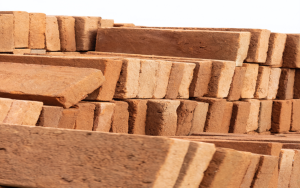Green materials in construction are being viewed as a sustainable development trend in the current period. To obtain green building certification (LEED, EDGE, LOTUS, etc.), depending on the rating points of each type of certification, green materials will have to account for a certain proportion of the structure of the building materials used for the project. As a self-identified Green Contractor, Tona Construction is currently using these environmentally friendly materials for its projects to minimize the negative impact of traditional building materials on the environment.
The negative impact of traditional building materials
Commonly mentioned building materials are often known for their unfriendly environmental characteristics, particularly fired clay bricks and fired materials in general. They are considered difficult to recycle after demolition and are not beneficial to nature when decomposing.
The production process of fired bricks, produced according to standards, is estimated to consume a large area of agricultural land at a depth of 2m, thousands of tons of coal, and also release a large amount of CO2 into the environment. In addition, construction waste and demolition waste account for up to 8% of the total waste in Vietnam, but only 21 provincial cities have a sanitary collection system.
In addition to fired bricks, some other “less” environmentally friendly materials can be mentioned, such as cement, coal-fired power plants, iron and steel, paint, solvents, etc. All of these materials have a significant negative impact on the environment.

Establishing green regulations
To reduce harm to the environment, first, the functionality and lifespan of construction materials must be increased. Common recyclable materials nowadays are steel, copper, aluminum, concrete, glass, wood products, gypsum boards, etc. Raw materials that consume fewer natural resources and can be quickly recycled are encouraged by environmentalists, such as wood and wood products, bamboo, and natural fiber paint. In addition, some environmentally friendly building materials include non-fired bricks, metal roofing, XPS insulation, etc.
- Non-fired bricks: A super lightweight type of brick made from fine-ground sand and crushed stones combined with cement, lime, gypsum, aluminum compounds, and water, without going through the firing process. They have good soundproofing, heat insulation, energy-saving, high accuracy, durability, and are eco-friendly and healthy for humans.
- XPS insulation: XPS foam is made from PS plastic through a special process in which the stiff, expandable sheet is molded and the structure of the foam is welded and foamed. The product has good insulation for both hot and cold, is easy to shape and cut, is lightweight, and is low-cost, so it is widely used.
- Cellulose roofing: Roofing sheets made from cellulose (organic fiber) that do not contain cancer-causing asbestos like banned roofing sheets today. The sheet is produced by a layer pressing method, the surface is coated with acrylic with multiple coatings to create elasticity for the product. Cellulose roofing sheets are widely used because of their good soundproofing, heat insulation, wind resistance, lightweight, etc.

In Vietnam, most construction materials such as non-fired bricks, cement, cladding materials, etc. are made from waste sources from various industries. The goal of achieving net zero emissions also includes developing cities and urban areas towards sustainable development and energy efficiency. To achieve this, every green project must be built with green materials, including raw materials. The production of green construction materials also requires a lot of technology and raw materials. However, the only limitation that is currently hindering the development of green materials is their high cost.
Tona Construction applies green materials to professional Design – Construction activities in the Industrial, Commercial, and Civil construction sector. A typical example is the construction project of Spartronics Nam Tan Uyen factory with an area of 40,000m2 in Binh Duong province. The project achieved the LEED Gold standard in the LEED standard scale of the US. Green Building Council with 25% of construction materials from waste sources and 100% of the carpet used in the building received the Green Label Plus. In addition, the project also achieved a nearly 40% green coverage ratio.
See more: Spartronics Vietnam 2 Factory – Nam Tan Uyen Industrial Park, Binh Duong

In summary, using green materials in construction design brings significant benefits. Green construction materials are often produced from recycled or reused materials, reducing waste and consuming natural resources. Besides, these materials also help reduce emissions and save energy during production and use. Although green construction materials are more expensive than traditional materials, they have a longer lifespan, which helps keep maintenance and repair costs in the future. The use of these materials also helps save energy and reduce electricity costs during use. Green building materials have the ability to absorb and treat harmful substances in the air, improve air quality, and create a healthier living environment. Green construction materials often have unique shapes, colors, and textures, helping to create a beautiful, luxurious, and attractive living space.


Recent Comments